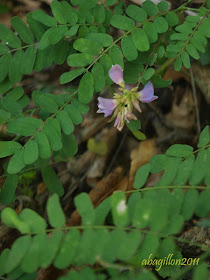Some plants, flowers and fruits we always see in our property are still unknown to me, meaning I don't call them by first names. I know the locations they can be seen, their visual characteristics or morphology, sometimes even the insects associated with them. Yet, i cannot find their identity. Now, November 2012, I remember to come back and put its proper ID, I baptize you
Capparis micracantha. Actually, i have already posted the flower of this bushy tree years ago, but i didn't know that flower becomes this red fruit when ripe. (I am sorry for those who came back to know it, but i forgot my responsibility to return, thank you). This is the
previous post: http://abagillon.blogspot.com/2009/10/wildflowersthats-what-we-thoughtat.html
This very colorful fruit is already ripe. It is typically green when unripe but i haven't documented yet its flowers. I am very familiar with its leaves and spiny branches though, i can even identify its seedlings. The fruits when still at the tree is always associated with black ants. I've been looking for other insects where the black ants associate themselves with, but I cannot see any! However, even the green fruits are already surrounded with these black ants. In fact, it is difficult getting this red fruit because the ants cling to the hands.
The fruit is full of black seeds surrounded with mucilage. It looks like the pomegranate seeds. However, it has an aroma that is not fully foul but is unpleasant. I haven't seen though if birds eat these fruits. I remember last time i also posted almost the same color of fruit from a friend's farm, but that was from a vine. This one is from a tree, actually a forest wild tree.
Another lovely red colored seeds are those small ones. We have a lot of them growing in the wild thickets. They are borne in pods from a bushy vine. The black portion contains the hilum which is attached to the pod. It is very hard when fully dry.
We locally call it 'saga', pronounced slowly with weight on the last syllable. Its seed pods impressively split open to reveal these brilliant red seeds with black tips. It is commonly made into beads, bases for calling them as rosary peas, a very nice name but very poisonous when ingested. I finally found its scientific name, Abrus precatorius.
Scattered on green grass they provide some nice happy color contrast
This is the flower and the leaves of the small red seeds.





![Outdoor-Wednesday-logo_thumb1_thumb1[1]](https://blogger.googleusercontent.com/img/b/R29vZ2xl/AVvXsEglJd8GIjrs07pJOeyu5DQ5LZgnCivVTFMPKMmf_6gwZ-qYqxWAER-GyJCFKmal8LyHltSNo4RNOJwdzL1Fo5vreadoF8NZBBGnz-MmRsskS5rhUscdpTAOOJIoCafxNzdptEKh9_O3s6c/?imgmax=800)
I think we have a similar seed which is strung into necklaces.
ReplyDeleteI'm steadily moving towards only planting what is indigenous to South Africa - we have such a selection to choose from, and OTH such problems with invasives.
Hi Diana, thanks for your visit. Some people here are also trying to do that, however, those fanatic in weeding out the introduced don't have much lands to do their passion, while the landed are still getting in more exotics! Haaaay!
DeleteI've seen this plant before. The fruit reminds me of a passion fruit. Now that's a fruit I enjoy. Sounds like an interesting plant to have around:)
ReplyDeleteMaybe you saw the fruit from my previous post, but that was from a vine, although the fruits look the same.
DeleteCan you play cricket with it ?
ReplyDeleteHahaha, b-a-g, we don't have cricket games here. I only saw cricket in Australia, very famous there as carry over from EU. The cricket we have here are the jumping ones.
DeleteIs the first one a durian fruit? I've read about them and know the fruit doesn't smell good, but I've never seen one.... all of your fruits and flowers make good pictures. Thanks for sharing!
ReplyDeleteSallie, durian fruits look very much different from this one and its odor is definitely arresting. You can google for durian image, beautiful shape too.
DeleteThose are the coolest seeds and I like the lacy leaves and petitie flowers.
ReplyDeleteWe used to play with the seeds as children. Now I'm so glad to know their name and it brings back a lot of memories. Andrea, please visit my Facebook page. I have posted the EO picture.
ReplyDeleteWonderful fruit.
ReplyDeleteSydney - City and Suburbs
Very informative and creative post ~ Great photography~ thanks, namaste, (A Creative Harbor)
ReplyDeleteThe saga seeds reminded me of my wonderful childhood. we used to play games like 'five stones' in school and those stones are little bags filled with rice, sand or saga seeds. Hardly see children playing these nowadays.
ReplyDeleteHow lovely it really is during our days, when our social lives are personal and not virtual yet. The new generations don't even know it but FB and computer games. Do you also call them 'saga' in Malay?
DeleteI have never seen this fruit before. Interesting post.
ReplyDeleteJoyce M
it was really red. :) Don´t think I have tasted it.
ReplyDeleteIt is not actually eaten by humans, i haven't learned if anybody or any bird eat it at all. It is a forest tree fruit from the wild.
Deletere your question on my meme NF Blo-Ma.
ReplyDeleteThis meme is for both flowers and for macros in general. That is because people wanted 2 memes, one for each, but I thought one would be enough. It works well. So, you are welcome to join in. :)